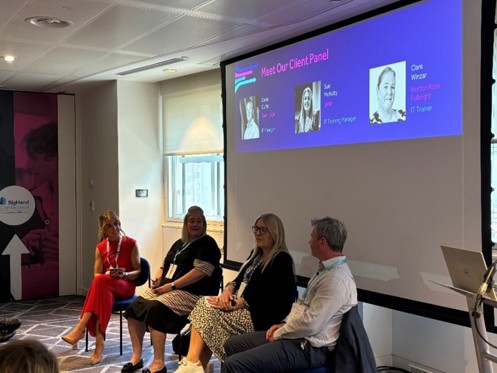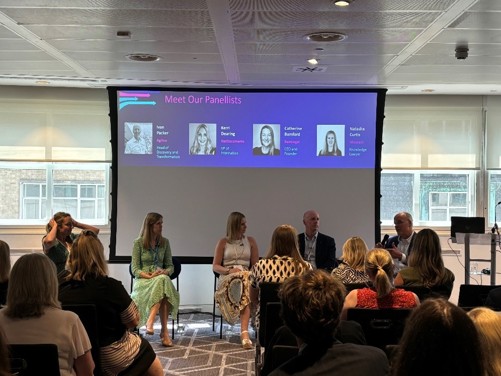Mastering the Foundation: Essentials of Effective Legal Documents
BigHand’s Chief Marketing Officer Briana McCrory chaired a panel of legal technology experts featuring Clare Winzar, IT Trainer at Norton Rose Fulbright, Sue McNulty, IT Training Manager at JMW, and Gavin Curtis, Head of IT at Town Legal. The session tackled the importance of centralized template management systems with an emphasis on how building on a solid foundation garners the best results from that solution.
When reflecting on their adoption of BigHand Document Creation at Town Legal, Gavin said that the only thing he would’ve changed, internally, was to establish a “template committee”. He elaborated by describing this as people from different parts of the business to support and streamline the decision-making process. Through selection of a core group of relevant people to drive the integration of new tech, those committee members can ensure that the requirements of their business areas are met by the software.

Similarly, Sue observed that allocating a designated “superuser” from each department at JMW would have benefited them when rolling out their new approach to legal documents. This omission impacted how streamlined the process was following the rollout of the new templates. By establishing subject matter experts to champion the technology, firms can drive more effective and compliant use of the tool following the proper configuration and appropriate training for template system administrators and users.
The element of consistency in approach is vital to legal documentation. Clare explained how Norton Rose Fulbright have a “house style committee” to support the firm in delivering consistent and compliant product. Template Management Solutions which empower firms to create and manage templates in-house, which are used firm-wide, greatly support these efforts. When put like this, it seems quite simple and that’s because again, we return to the notion of getting the basics right before introducing advanced tech solutions. Clare aptly summarized this in her key takeaway message for the audience to get their “ducks in a row”. To establish precisely what you aim to achieve by implementing a template management system before diving in.
Legal Document Creation: Are We Getting Distracted and Missing the Fundamentals?
There has been much talk about AI in the legal industry (including here at BigHand!), and BigHand’s President, Global Legal Market, Eric Wangler asked this session’s expert panel why they think it’s “critical for law firms to focus on the basics?” The session began with a similar message to the one on which the previous panel had ended:, with Catherine Bamford, CEO and Founder of BamLegal observing that “when documents aren’t standardized, it reflects badly on how joined-up the service is”. Again, we heard how critical it is for firms to establish the fundamentals of their legal documents and “map the process” before introducing newer solutions if they are to maximize the benefits that technology can offer.
Alongside Catherine and Eric were Natasha Curtis, Knowledge Lawyer at Mourant, Kerri Dearing, VP of International at NetDocuments, and Ivan Packer, Head of Discovery and Transformation at Agilico. Across the board, speakers emphasized the importance of solid foundations and content management. Kerri said, “with AI coming to the forefront, it's pushed people to focus on the fundamentals and building those foundations.” She went on to say that “content is your expertise, it needs security and governance – even if you layer on AI, maintaining that governance and security is important”. Ivan agreed, stating that firms should first consider consistent, compliant formatting and saving of documents to avoid “putting new tech onto old documents” Having learned in the previous session just how important a solid foundation is for law firms to ensure consistent client service delivery and output, in this session, it became clear that these foundations form a vital springboard from which firms wishing to take best advantage of automation and AI.

The speakers were in agreement that whilst AI definitely has a place in the future of legal documents, it should be applied selectively. Drafting of precedents, for example, is not a good use case for generative AI since firms don’t want a result which is different every time but instead is based solidly on ‘if, then, else’ to ensure consistency. All agreed that there must be a balance between machine and human contributions and a requirement to work within the core structures and processes of the firm. Catherine described a “mass hysteria around generative AI” and how this increased attention has resulted in “a lot of appetite from lawyers for legal tech”. Harnessing this enthusiasm can help law firm leaders in encouraging risk-averse lawyers to fully embrace and adopt new tech initiatives.
On finding a balance between machine and human expertise, I was reminded of a key learning from the keynote speaker at the BigHand Conference. Paul McGee (aka The SUMO Guy) talked about the importance of “people intelligence” in a world obsessed with artificial intelligence. While innovative technology is the key to the law firm of the future, we need support from people who have the openness and curiosity to drive change. When applied in the context of legal firms looking to adopt AI, Kerri highlighted the importance of collaboration between stakeholders to address the question “how does the firm want AI to fit within their strategy?” and to be clear which specific challenges they wish it to solve.
For me, the overarching takeaway from the conference on the subject of document creation technology, Is how crucial it is for firms to approach innovation in the proper order informed by solid business analysis. Involvement of a senior stakeholder, working with lawyers, support staff, IT and suppliers from the outset is key to success realization. Whilst the advent of AI and other technologies is exciting and presents a wealth of opportunity for the law firm of the future, for legal document production, a consistent, compliant foundation and the appropriate, timely involvement of the right people is key to driving successful change.








